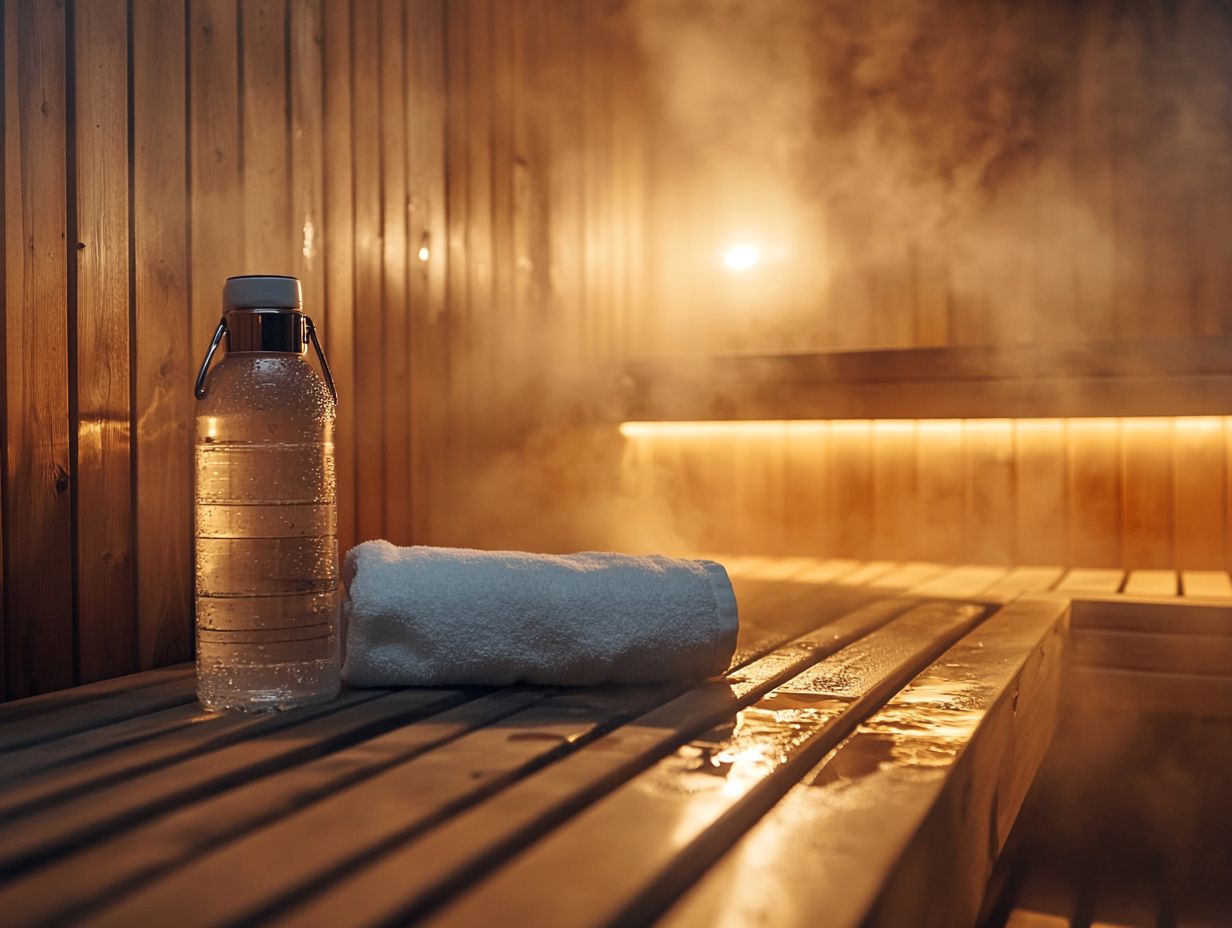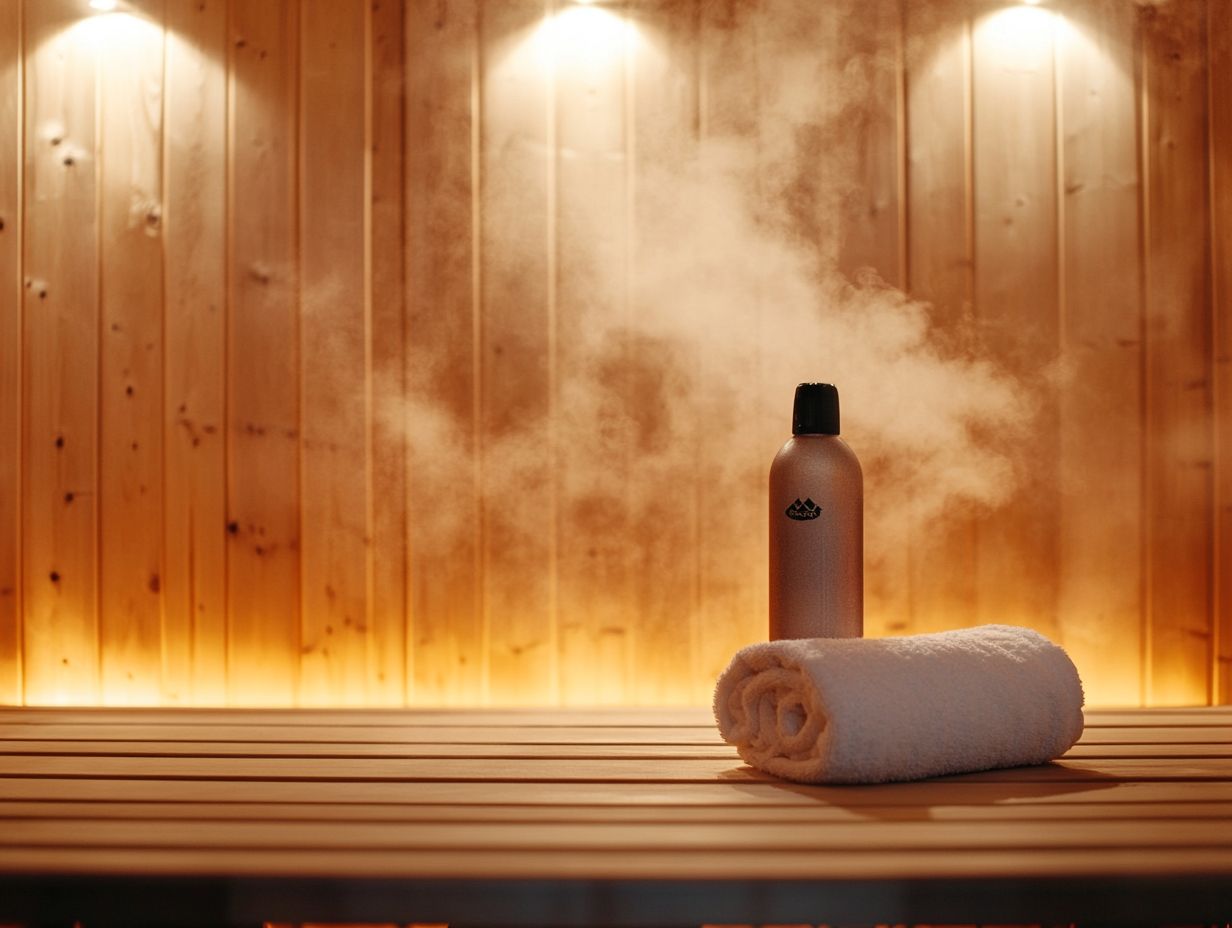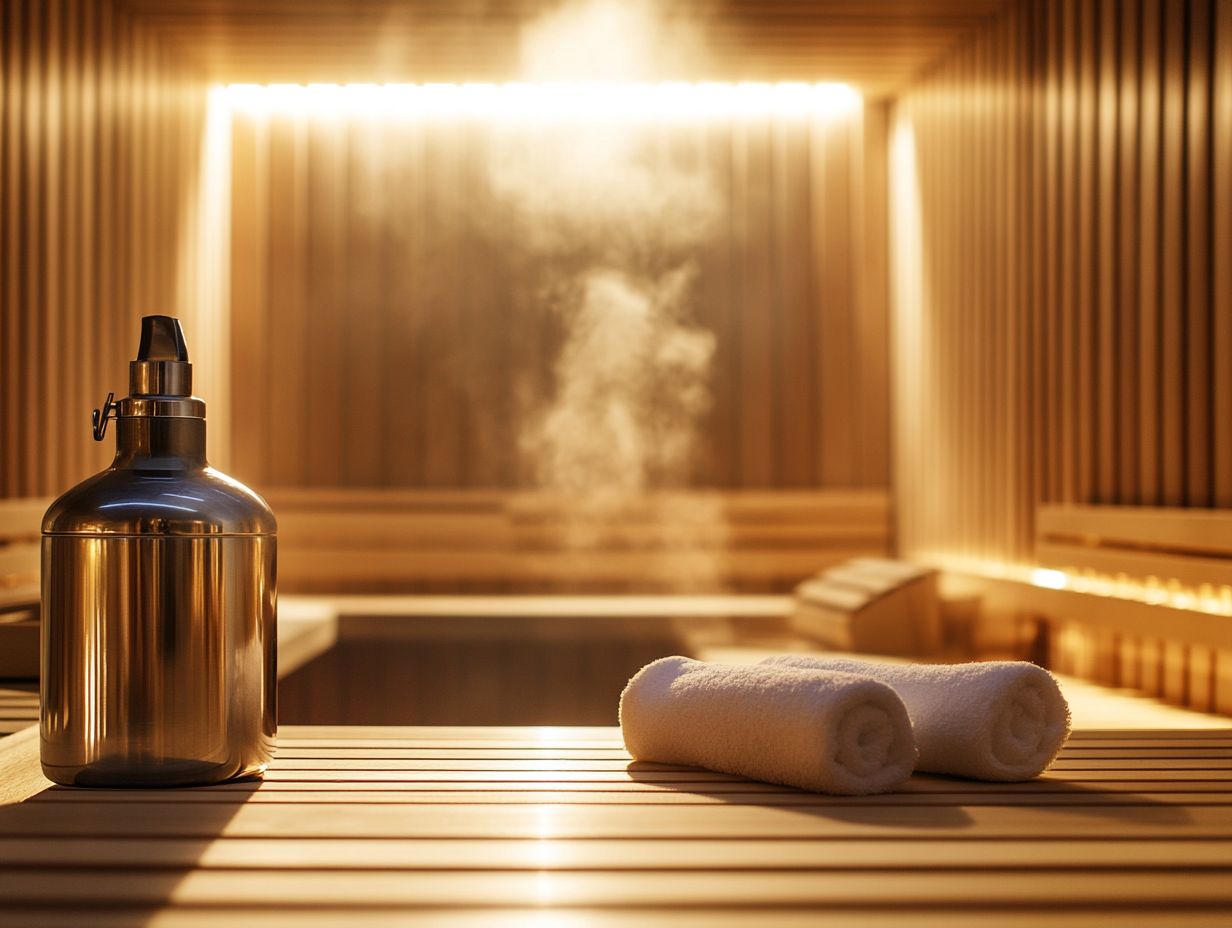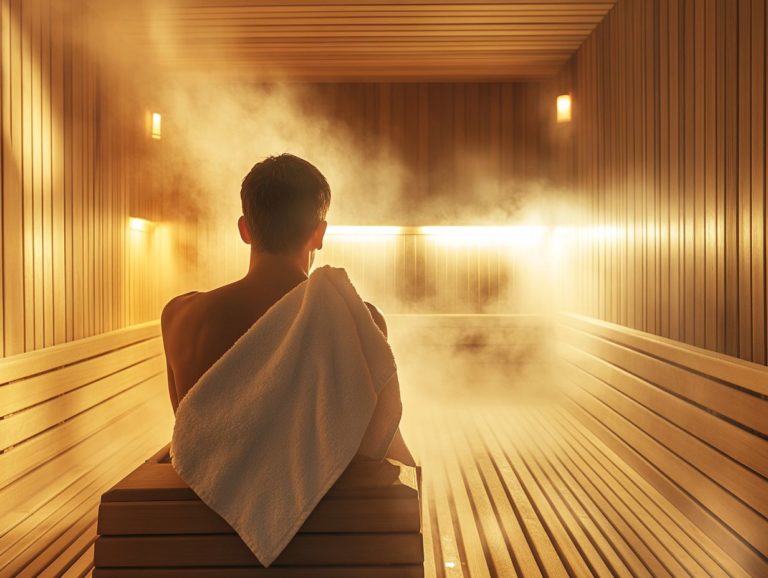5 Benefits of Saunas for Athletic Recovery
Saunas have long been revered not just for their serene atmosphere but also for a plethora of benefits that extend well beyond relaxation.
As an athlete, incorporating sauna sessions into your recovery routine can yield remarkable enhancements in both performance and overall well-being. Saunas help improve blood circulation, alleviate muscle tension, and bolster your immune system. The advantages of saunas are truly extensive.
Experience how saunas can support exercise recovery, explore the various sauna types available, offer guidance on recommended usage, address potential risks, and provide tips for seamlessly integrating this powerful tool into your training regimen. Immerse yourself in the insights ahead to discover how a simple sauna session can elevate your athletic journey to new heights!
Contents
- Key Takeaways:
- 1. Increases Blood Flow and Circulation
- 2. Relieves Muscle Tension and Soreness
- 3. Flushes Out Toxins and Impurities
- 4. Promotes Relaxation and Reduces Stress
- 5. Boosts Immune System
- How Do Saunas Aid in Athletic Recovery?
- What Are the Different Types of Saunas?
- What Are the Recommended Usage and Duration of Saunas for Athletes?
- Are There Any Risks or Side Effects of Using Saunas for Athletic Recovery?
- What Are the Other Benefits of Saunas for Overall Health and Wellness?
- How Can Athletes Incorporate Saunas into Their Training Routine?
- Frequently Asked Questions
- What are the benefits of saunas for athletic recovery?
- Are there any potential risks or drawbacks to using saunas for athletic recovery?
- How often should athletes use saunas for recovery?
- Can saunas be used for injury recovery?
- Can saunas help with weight loss?
- Are there different types of saunas that are better for athletic recovery?
Key Takeaways:

- Increased blood flow and circulation from sauna use help with muscle recovery and reduce soreness after intense workouts.
- Saunas aid in flushing out toxins and impurities, promoting faster recovery and boosting the immune system for athletes.
- Incorporating saunas into your training routine can aid in relaxation, reduce stress, and improve overall health and wellness for athletes.
1. Increases Blood Flow and Circulation
Using a sauna can elevate your game by significantly enhancing blood flow and circulation. This is essential for athletes and fitness enthusiasts like you, as it helps with muscle recovery, boosts cardiovascular health, and improves overall endurance performance.
When you step into that soothing heat, your core temperature rises, triggering beneficial physiological responses that support your post-workout recovery. This ensures essential nutrients reach your muscles efficiently.
This process not only reduces soreness but also helps flush out toxins and minimize inflammation. As your blood flow increases, those critical nutrients are delivered swiftly, leading to quicker healing times and enhanced performance. Regular sauna sessions can also improve cardiovascular health research shows that heat exposure can enhance heart function and boost aerobic capacity.
Athletes who weave sauna use into their routines often report increased stamina and a heightened sense of well-being. It s a powerful tool for anyone looking to optimize their fitness journey!
2. Relieves Muscle Tension and Soreness
Utilizing a sauna effectively helps relieve muscle tension and soreness, promoting relaxation and enhancing joint mobility. Both are essential for athletes recovering from intense training sessions or competitions and improving flexibility.
As the warmth envelops your body, it encourages increased blood flow, facilitating the delivery of nutrients to tired muscles and accelerating the healing process. This not only alleviates discomfort but also significantly enhances your overall flexibility, allowing for smoother movements and better performance.
The activity of heat shock proteins proteins that help repair damaged tissues triggered by high temperatures, plays a crucial role in muscle recovery. Beyond the physical benefits, regular sauna use can sharpen your cognitive function by inducing a deep state of relaxation, which leads to improved focus and mental clarity key components for athletes aiming to maintain peak performance.
3. Flushes Out Toxins and Impurities
Saunas are incredibly effective at flushing out toxins and impurities from your body, promoting skin health and overall wellness through deep sweating during sessions, which also aids in glucose regulation.
This natural detoxification process helps unclog your pores, expelling dirt and sebum, leading to significant improvements in skin conditions like acne and eczema. As you sweat, you release harmful substances and stimulate circulation, allowing essential nutrients and oxygen to reach your skin and enhance its overall appearance.
It s essential to remember that hydration is key to maximizing these health benefits. Drinking water before and after your sauna sessions helps prevent dehydration, ensuring your body remains well-hydrated to support optimal detoxification and rejuvenation of your skin.
4. Promotes Relaxation and Reduces Stress

Spending time in a sauna is a luxurious way to unwind and significantly lower your stress levels. It s a perfect choice if you’re on a quest for mental wellness and enhanced cognitive function.
Imagine stepping into a peaceful sauna that invites you to relax. This tranquil environment encourages you to engage in deep breathing techniques, which can profoundly impact your body.
As you concentrate on your breath, you activate a part of your nervous system that helps you relax. This results in a decrease in heart rate and blood pressure.
Over time, these practices cultivate a state of calmness that seeps into your daily life, aiding in long-term stress management.
Regular visits to the sauna create a sense of community. You have the chance to connect with others and share experiences, enriching your mental health and contributing to overall well-being.
These practices enhance your sense of well-being, transforming the sauna into more than just a physical escape.
5. Boosts Immune System
Dive into sauna sessions to supercharge your immune system! Regular sauna sessions can significantly boost the production of white blood cells, improving your body s ability to fend off infections and reduce inflammation.
This remarkable benefit stems from heat exposure, which minimizes damage caused by harmful molecules in the body. Research suggests that the elevated temperatures in saunas trigger cellular responses that bolster your resilience against illnesses.
Consistent sauna use not only promotes cardiovascular health but also contributes to your mental well-being by alleviating stress levels. By making sauna sessions a part of your routine, you enjoy a holistic enhancement to your health, ultimately fortifying your defense against various pathogens.
How Do Saunas Aid in Athletic Recovery?
Ready to supercharge your routine? Start incorporating sauna sessions today! Saunas boost muscle recovery through improved blood flow, increased sweat production, and elevated growth hormone levels.
When you step into a sauna, the heat dilates your blood vessels, promoting better circulation. This means more oxygen and nutrients flow to your fatigued muscles, effectively reducing soreness and alleviating inflammation.
This process expedites the healing of pesky microtears that often occur during intense workouts. If you’re adding sauna sessions to your routine, schedule them post-workout for the best results.
Just remember to stay adequately hydrated before and after. This practice not only helps your muscles relax but also boosts your overall mental well-being, laying a strong foundation for your next training session.
What Are the Different Types of Saunas?
Different types of saunas Finnish, infrared, and steam offer distinct experiences and benefits, all centered around heat exposure and relaxation.
Each sauna type varies in how it delivers heat, shaping your journey toward relaxation and health. The Finnish sauna employs dry heat, typically ranging from 150 F to 195 F, encouraging intense sweating and deep muscle relaxation.
In contrast, infrared saunas use light waves to warm your body directly, offering tolerable temperatures while penetrating deeper into your skin tissues. This can be particularly beneficial for those dealing with joint pain.
Meanwhile, steam saunas envelop you in a humid environment, soothing for respiratory issues and excellent for skin hydration.
Understanding these nuances enables you to tailor your sauna experience to achieve specific health goals, whether that s detoxification, cardiovascular benefits, or simply unwinding after a long day, while considering sauna etiquette for an optimal experience.
What Are the Recommended Usage and Duration of Saunas for Athletes?

For athletes like you, it s recommended to indulge in sauna sessions for about 15-20 minutes. Remember to hydrate properly before and after to enhance muscle recovery and relaxation.
Incorporating these sessions after your workouts can elevate your body s ability to flush out toxins while boosting blood flow to sore muscles. Many athletes find that visiting the sauna two to three times a week is highly beneficial, creating a consistent routine that fits into their training schedules.
Drink water or drinks that help replace important minerals lost during sweating both before stepping into the sauna and right after. This supports your recovery and helps you maintain peak performance for your upcoming workouts.
Are There Any Risks or Side Effects of Using Saunas for Athletic Recovery?
While saunas provide many health benefits, be aware of potential risks and side effects, such as dehydration and low blood pressure, particularly when you’re pushing your athletic limits.
Understanding these risks can help you optimize your recovery routines while minimizing adverse effects. It’s especially important to tune into your body’s signals, ensuring you hydrate adequately before and after your sauna sessions.
Keeping an eye on your time spent in the sauna is key to preventing overheating and fatigue. Set a timer to establish a structured routine that balances heat exposure with necessary breaks, enhancing your overall recovery experience.
Incorporating these strategies promotes safer sauna use and allows you to fully relish the benefits of sauna therapy.
What Are the Other Benefits of Saunas for Overall Health and Wellness?
Saunas offer numerous health benefits that extend beyond athletic recovery, enhancing your mental wellness, improving skin health, and increasing flexibility. Incorporating sauna sessions into your wellness routine can be a game changer.
Regular sauna use has been linked to sharper cognitive function, as the heat boosts blood flow to your brain, potentially leading to heightened focus and clarity. Research shows that sauna usage promotes cardiovascular health by improving circulation and lowering blood pressure, helping you develop a more resilient heart.
Many users have reported transformative effects on their skin, often comparing regular sauna baths to invigorating facials that detoxify and rejuvenate. A recent study revealed that participants experienced significant improvements in skin conditions like acne and psoriasis, underscoring the multifaceted advantages of this ancient practice.
How Can Athletes Incorporate Saunas into Their Training Routine?
You can seamlessly integrate saunas into your training routine by scheduling regular sessions after workouts. This approach promotes muscle recovery and enhances your endurance training.
Timing plays a critical role; stepping into a sauna shortly after high-intensity workouts can significantly amplify the benefits of increased blood flow and relaxation of tight muscles. Adjust your sauna frequency based on your week s training intensity more frequent sessions may be advantageous following particularly grueling workouts, while lighter training weeks could call for less heat exposure.
Proper hydration is essential; the heat can lead to considerable fluid loss, so replenishing electrolytes and water before and after your sauna use should be a top priority to ensure optimum performance and recovery.

Frequently Asked Questions

Have questions about how to incorporate saunas into your training routine? Don’t miss out on the incredible benefits of regular sauna use try incorporating sauna sessions into your routine and feel the difference!
What are the benefits of saunas for athletic recovery?
1. Improved muscle recovery: Saunas can help increase blood flow and circulation. This can reduce inflammation and promote faster muscle recovery after intense workouts.
2. Cleaning out the body: Sweating in a sauna helps rid the body of toxins and waste products that build up during intense physical activity.
3. Reduced muscle tension and soreness: Saunas help relax muscles. This reduces tension and soreness after workouts.
4. Boosted immune system: Regular sauna use can increase your body’s defense cells. This helps boost the immune system and can prevent illnesses.
5. Mental relaxation: Step into a sauna for a peaceful escape and let your body unwind. It promotes mental relaxation and stress relief.
Are there any potential risks or drawbacks to using saunas for athletic recovery?
While saunas offer many benefits, athletes should be cautious and listen to their bodies. Spending too much time in a sauna or not hydrating properly can lead to dehydration and heat-related illnesses. It’s also best to avoid saunas if you have pre-existing medical conditions that heat may worsen.
How often should athletes use saunas for recovery?
The frequency of sauna use varies for each individual. Start with two to three sessions a week. Adjust based on how your body feels after each session.
Can saunas be used for injury recovery?
Yes, saunas can aid in injury recovery by promoting blood flow, reducing inflammation, and providing relaxation for the injured area. However, consult with a medical professional before using a sauna for injury recovery. Avoid using it if it aggravates the injury or causes discomfort.
Can saunas help with weight loss?
While saunas aren t a magic weight loss solution, they can jumpstart your efforts! They promote detoxification and can help reduce water weight. For long-term success, combine sauna use with a healthy diet and regular exercise.
Are there different types of saunas that are better for athletic recovery?
There are various sauna types. Traditional steam saunas, infrared saunas, and dry saunas each offer unique benefits. Explore them to find your favorite!






